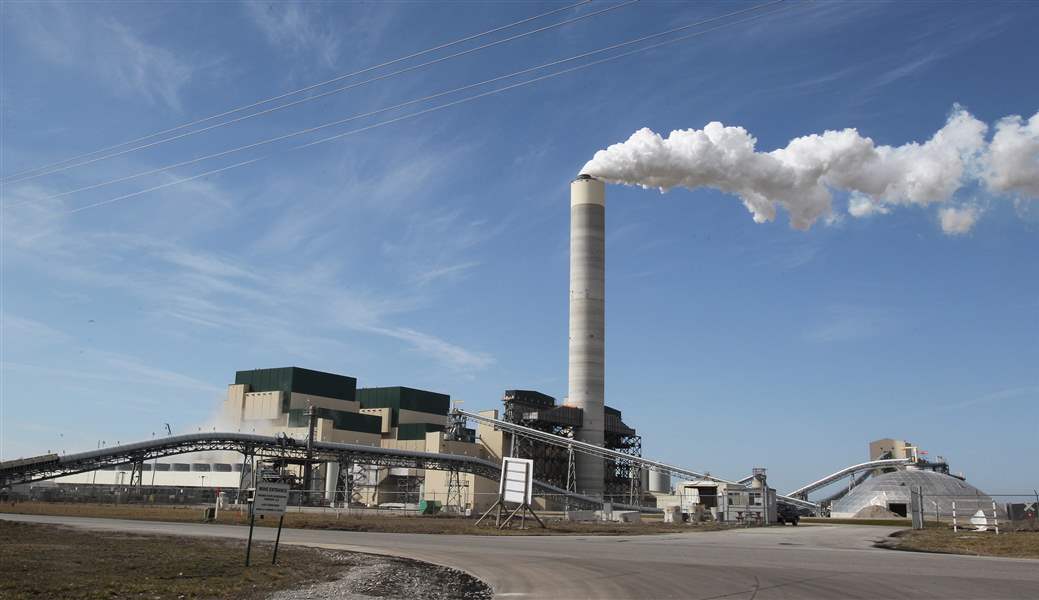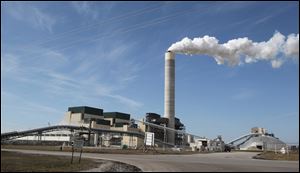
B.G. residents seek state investigation
Controversial power plant investment at issue
5/12/2014
The view from across the road at the Prairie State Energy Campus facility in Belleville, Ill.
BELLEVILLE NEWS-DEMOCRAT

The view from across the road at the Prairie State Energy Campus facility in Belleville, Ill.
BOWLING GREEN — Angered by rising electric rates, several Bowling Green area residents want Ohio Attorney General Mike DeWine to investigate how Columbus-based American Municipal Power got 68 of its member communities to invest in one of the Midwest’s largest and most controversial coal-fired power plants built in more than 30 years.
Residents said at a recent meeting at First Presbyterian Church in Bowling Green they are prepared to gather signatures and deliver petitions to Mr. DeWine’s office if Bowling Green officials continue to ignore the $1 billion in cost overruns of the Prairie State Energy Campus in southern Illinois.
The project’s price tag now exceeds $5 billion, with numerous operational problems still being worked out.
As a nonprofit municipal co-op, AMP is not subject to regulation by the Public Utilities Commission of Ohio. Even the Ohio Office of Consumer Counsel, which represents ratepayers in cases involving for-profit utilities such as FirstEnergy Corp., doesn’t have jurisdiction.
About all Mr. DeWine’s office can do is look for evidence of fraud or some other violation that could get Bowling Green out of its contract without a huge penalty, according to David Schlissel, an attorney-consultant on engineering and economic issues who has testified in more than 100 cases before regulatory boards, commissions, and courts in 35 states.
Mr. Schlissel is president of Schlissel Technical Consulting and director of resource planning analysis for the Cleveland-based Institute for Energy Economics & Financial Analysis. The IEEFA group is charging that AMP either misled or grossly underestimated Prairie State’s problems when the co-op signed up communities as investors in 2007.
“Maybe they can’t get out of the contract,” Mr. Schlissel said near the end of a 90-minute presentation he made to 60 area residents on April 24. “But wouldn’t it be a good thing for [the attorney general’s office] to investigate?”
Mr. DeWine’s office has declined comment for weeks. It did not respond when asked about Mr. Schlissel’s presentation.
“I can’t promise you that you can get out [of the deal],” Mr. Schlissel told the audience. “I can promise you, though, that we have a lot of information to help get an investigation started.”

Kent Carson, AMP’s senior media relations director, confirmed AMP is exempt from PUCO and OCC oversight.
He said AMP has done nothing wrong.
Mr. Carson said AMP was created by, is owned by, and works for its members.
He said AMP proposed investments in Prairie State only after the co-op was instructed to seek out a solid, long-term investment for baseload power — that is, electricity produced 24 hours a day to meet each respective community’s minimum needs.
The request was made because of lingering uncertainty over electricity prices on the open market, Mr. Carson said.
“AMP and its members are one and the same,” Mr. Carson said. “Our obligation is to assist in long-term power planning and decrease exposure to the wholesale power market.”
In a three-page written statement to The Blade, Bowling Green officials echoed that.
“In the mid-2000s environment, the energy market was very volatile. Major price swings and frequent high prices made buying on the open market an unattractive and risky option,” the city’s statement said.
The irony, according to Mr. Schlissel, is that Bowling Green could be buying electricity cheaper on the open market today than the price it is paying to get it from Prairie State.
That, according to Mr. Carson, is Monday-morning quarterbacking. Few experts predicted back in 2007 the new era of hydraulic fracturing of shale, or “fracking,” would drive down natural gas prices as quickly as they have, he said.
“In the years since the city made its decisions, the market has changed and, at this time, market prices are down. However, much of the energy market change has come from the recession and lack of economic recovery and the abundance of natural gas,” the city agreed in its statement. “The increase in supply from natural gas is due to the development of fracking technology which many of our citizens and officials oppose.”
AMP’s trustees
The composition of AMP’s 20-member board of trustees is a sign of how AMP and its members are one and the same.
Napoleon City Manager John Bisher is the board’s chairman. Montpelier Village Manager Pam Lucas is the board’s secretary. Other board members include Brian O’Connell, Bowling Green utilities director, Brian Carlin, Bryan utilities director, and officials from other member communities.
AMP’s critics allege the arrangement is too cozy, that it makes it more difficult for communities to remain objective.
Mr. Carson said people forget AMP works for the communities. He said if residents don’t like decisions they make after consulting with AMP, they can replace local officials.
But Mr. Schlissel said residents may be unaware that AMP passes liability for investments along to the group’s member communities, which residents fund.
He said AMP presented Prairie State as a deal too good to pass up.
Bowling Green officials now find themselves trying to justify the hefty risk the city assumed, Mr. Schlissel said.
Records show Bowling Green’s commitment to buy 35 of the project’s 1,600 megawatts is the largest investment in the state of Ohio.
Bowling Green is one of 217 municipalities from eight utility consortia, most of them east of the Mississippi River, that became Prairie State’s part-owners.
AMP negotiated shares from the developer, Peabody Energy, which has sold off all but the minimum 5 percent it was required to maintain in the project.
“My guess is they’re embarrassed because they know it’s a bad deal,” Mr. Schlissel said of Bowling Green officials. “They know it is. They’re embarrassed because they were misled or didn’t do enough research.”
The city denied that in its statement.
“Our officials are hard-working, engaged, and pro-active,” the statement said.
Mr. Carson called Mr. Schlissel’s allegation “outrageous and insulting.”
Of the 68 AMP member communities financially committed to Prairie State, 62 of them are in Ohio. Three are in Virginia; two are in Michigan, and one is in West Virginia.
More than a third of those from Ohio are in the northwest part of the state. Those communities include Bowling Green, Milan, Republic, Ohio City, Genoa, Sycamore, Bryan, Deshler, Montpelier, Edgerton, Oak Harbor, Pemberville, Arcadia, Napoleon, Carey, Woodville, Bloomdale, Elmore, Bradner, Pioneer, Clyde, and Holiday City.
None has the degree of investment of Bowling Green.
Even Cleveland, with 24.9 megawatts, has a smaller commitment.
Utilities deal in what’s known as baseload and peak usage periods. The latter is when customers use the most electricity, such as when they crank up their air conditioners during summer heat waves.
Bowling Green needs 104.657 megawatts to meet those peak-usage periods.
A few years from now, Prairie State is to provide 60 percent of Bowling Green’s minimum baseload needs and 33 percent of its peak requirements.
That will make Bowling Green twice as dependent on Prairie State as the average AMP member in Ohio.
According to Mr. Carson, the average AMP member in Ohio gets 17 percent of its peak requirements met by Prairie State.
Each community is potentially on the hook for decades.
Prairie State is expected to last 80 years, Mr. Carson said.
Bowling Green officials said it “would be irresponsible to think the city could walk away from any contract, let alone a contract financed with bonds.”
That, the city said, “would bring irreparable harm to the city’s strong bond rating and our ability to borrow toward future projects."
“The cost for litigation would be substantial and [would] bring a negative impact to our ability to provide basic services to our citizens,” the statement said.
The cost
Bowling Green is bracing its residents for a 25 percent rate hike, phasing it in at 5 percent annually for the next five years.
But the city attributes those rate hikes to higher capacity charges imposed by PJM Interconnection LLC, the regional grid operator, and planned increases to cover the city’s share in four new hydroelectric projects AMP is developing along the Ohio River. The four new hydro projects are in addition to two existing ones.
Officials said they expect all such costs to level off eventually — provided there are no more surprises at Prairie State.
“Are they still working through start-up challenges? Absolutely,” Mr. Carson said of Prairie State. “But it will work out in the long run. It’s a state-of-the art facility. We expected a shakedown period. We remain confident it’s a solid investment.”
AMP is owned and governed by 129 member communities in Ohio and five other states.
It negotiated ownership of 23.2 percent of the Prairie State project for member communities which agreed to invest in it in 2007.
Bowling Green’s largest energy user — Bowling Green State University — has some of the highest electric rates among Ohio public universities.
The university has declined comment on the Prairie State project.
Peabody Energy is America’s largest coal company. It has not responded to multiple requests for an interview.
It co-owns the mine adjacent to the Prairie State coal plant, as do communities that invested in the project.
The facility is called a mine-mouth plant, because the fuel source goes straight from the mine into the plant — thereby saving on transportation costs. Waste is also buried on site.
Officials estimate there’s enough coal in the mine to power the plant for at least 30 years. “The advantage of the plant from Day One was that it was a mine-mouth plant,” Mr. Carson said.
Critics accuse Peabody of concocting a deal to reap profits from a coal mine with limited value because of that coal’s high sulfur content.
Prairie States consists of two, 800-megawatt units in Marissa, Ill.
The units operated at only a combined 58 percent capacity from June, 2012, through January, 2014, far below the site’s operational goal of 85 percent capacity.
In April, the most productive of the two units operated at only 56.5 percent. The other one, down for maintenance part of the month, operated at only 28.7 percent, records show.
Timothy L. Schmitz, deputy Republican leader of the Illinois House of Representatives, said in a letter earlier this year he’d learned the project was being investigated by the U.S. Securities and Exchange Commission.
Contact Tom Henry at: thenry@theblade.com or 419-724-6079.